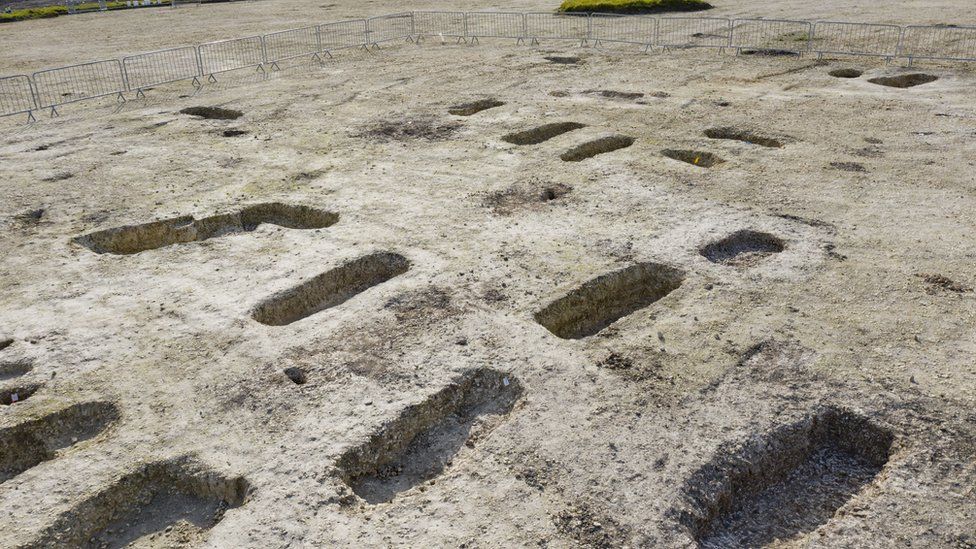ARTICLE AD BOX
 Image source, PA Media
Image source, PA Media
It is one of the largest Anglo-Saxon burial grounds ever uncovered in Britain
An Anglo-Saxon burial ground with 138 graves found along the route of HS2 is one of the largest ever uncovered in the UK, experts have said.
A skeleton with a weapon embedded in it, jewellery and weapons were among the finds in Wendover, Buckinghamshire.
Evidence of Neolithic, Bronze Age, Iron Age and Roman activity was also found.
Archaeologist Rachel Wood said the site's significance for the "historical and archaeological understanding" of Anglo-Saxon Britain was "huge".
The site contained 141 regular burials and five cremation burials. The male skeleton was found with a sharp iron object embedded into its spine, which experts believe may have caused or factored into his death.
Other items unearthed in the excavation last year include 89 brooches, more than 2,000 amber beads, 51 knives, 40 buckles and 15 spearheads.
Image source, HS2
Image caption,An iron spear point was found embedded into the spine of the skeleton of a man thought to be aged between 17-24
A number of objects likely to have been used for grooming were also found, including toiletry sets with ear wax removers and toothpicks, tweezers, combs and even a cosmetic tube that might have been used as eyeliner or similar.
The discoveries have been filmed for historian Dan Snow's streaming service History Hit.
Speaking on his podcast, the presenter said: "This stunning set of discoveries on the HS2 route can tell us more about how our predecessors lived, fought and ultimately died.
"It is one of the best and most revealing post Roman sites in the country and it was thrilling to join the team as they uncovered their wonderful finds."
Image source, PA Media
Image caption,A set of copper alloy small sqaure headed brooches from the 5th or 6th Century were uncovered
A female body was found buried with an array of high quality goods such as a complete ornate glass bowl made of pale green glass, multiple rings made of copper alloy, a silver "zoomorphic" ring, brooches, discs, iron belt fittings and objects made of ivory.
A team of about 30 field archaeologists from INFRA JV, working on behalf of HS2's contractor Fusion JV, completed field work at the site in 2021.
Analysis
The high speed rail line is a divisive project but away from the politics and debates, the programme is revealing secrets about Britain's past.
For the last five years, more than 1,000 archaeologists have excavated more than 60 sites.
This latest find is being described as rare and of national significance - it's being compared to that of Sutton Hoo, where an Anglo-Saxon ship was found in 1939 and thought to be the final resting place of the 7th Century King Raedwalk.
For some - even important archaeological discoveries still don't justify the construction of HS2 but for others this is chance to explore periods of our hidden history.
Ms Wood, lead archaeologist for Fusion JV, said: "The significance of this site for our historical and archaeological understanding of Anglo-Saxon Britain is huge.
"It is not a site I would ever have anticipated finding - to have found one of these burials would have been astonishing, so to have found so many is quite unbelievable."
She described it as a unique find due its size and scale.
"We have 141 individuals here, that's quite a large cemetery for the time that we know about, and over 70% of them have been found with objects which is really unusual," she said.
"Normally you might find one or two individuals in a small cemetery might have a comb with them or something like that and here we have so many individuals with multiple objects from weaponry to jewellery to grooming kits."
Image source, HS2
Image caption,A set of decorated copper alloy tweezers were also discovered in the HS2 excavation
A pair of small square-headed brooches were also excavated - a miniature form of the great square-headed brooch, such as the famous Chessell Down Brooch on display at the British Museum.
Two glass cone beakers that would have been used for drinking liquids such as wine were also found and suggest those buried might have had access to fine beverages from abroad.
Mike Court, lead archaeologist for HS2 Ltd, said: "We are just at the beginning of our understanding of how the discoveries will improve our historical knowledge of Britain.
"The archaeological finds made at this site in Wendover will not only be of interest to the local community but are of national importance, providing a valuable insight into life in Anglo-Saxon Britain."
The discoveries will be featured in a programme on Dan Snow's History Hit released on Thursday.
Image source, Cpl Danny Houghton RLC
Image caption,WO1 Halford joined soldiers from 2nd Battalion The Parachute Regiment to visit the Airborne Assault Museum in Duxford
Find BBC News: East of England on Facebook, Instagram and Twitter. If you have a story suggestion email eastofenglandnews@bbc.co.uk

 2 years ago
121
2 years ago
121








 English (US) ·
English (US) ·